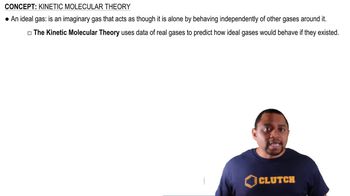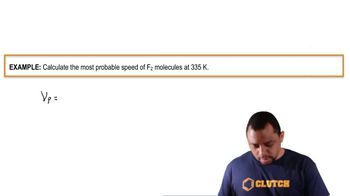Suppose you have two 1-L flasks, one containing N2 at STP, the other containing CH4 at STP. How do these systems compare with respect to (b) density?
Ch.10 - Gases
Chapter 10, Problem 81c
(c) Calculate the most probable speed of an ozone molecule in the stratosphere, where the temperature is 270 K.
 Verified step by step guidance
Verified step by step guidance1
Identify the formula for the most probable speed of a gas molecule, which is given by the equation: $v_{mp} = \sqrt{\frac{2kT}{m}}$, where $v_{mp}$ is the most probable speed, $k$ is the Boltzmann constant, $T$ is the temperature in Kelvin, and $m$ is the mass of one molecule of the gas.
Convert the molar mass of ozone (O$_3$) from grams per mole to kilograms per molecule. The molar mass of ozone is approximately 48 g/mol. To find the mass of one molecule, use the relation: $m = \frac{M}{N_A}$, where $M$ is the molar mass in kg/mol and $N_A$ is Avogadro's number.
Substitute the given temperature (270 K) and the calculated mass of an ozone molecule into the formula for the most probable speed.
Use the value of the Boltzmann constant $k = 1.38 \times 10^{-23}$ J/K in the equation.
Simplify the expression to find the most probable speed of the ozone molecule in the stratosphere.

Verified video answer for a similar problem:
This video solution was recommended by our tutors as helpful for the problem above.
Video duration:
3mWas this helpful?
Key Concepts
Here are the essential concepts you must grasp in order to answer the question correctly.
Kinetic Molecular Theory
Kinetic Molecular Theory explains the behavior of gases in terms of particles in constant motion. It posits that the temperature of a gas is directly related to the average kinetic energy of its molecules. This theory helps in understanding how temperature influences the speed of gas molecules, which is crucial for calculating the most probable speed of an ozone molecule.
Recommended video:
Guided course

Kinetic Molecular Theory
Most Probable Speed
The most probable speed of gas molecules is the speed at which the largest number of molecules are moving at a given temperature. It can be calculated using the formula v_mp = sqrt(2kT/m), where v_mp is the most probable speed, k is the Boltzmann constant, T is the temperature in Kelvin, and m is the mass of the gas molecule. This concept is essential for determining the speed of ozone molecules in the stratosphere.
Recommended video:
Guided course

Most Probable Speed Example
Ideal Gas Law
The Ideal Gas Law (PV = nRT) relates the pressure, volume, temperature, and number of moles of a gas. While the question focuses on speed, understanding the Ideal Gas Law provides context for how temperature and molecular mass influence gas behavior. It is foundational for comprehending the conditions under which ozone molecules exist in the stratosphere.
Recommended video:
Guided course

Ideal Gas Law Formula
Related Practice
Textbook Question
Textbook Question
Suppose you have two 1-L flasks, one containing N2 at STP, the other containing CH4 at STP. How do these systems compare with respect to (c) average kinetic energy of the molecules?
Textbook Question
(b) Calculate the rms speed of NF3 molecules at 25 °C.
Textbook Question
(c) Calculate the most probable speeds of CO molecules at 300 K.
Textbook Question
(c) Calculate the most probable speeds of Cl2 molecules at 300 K.
Textbook Question
Which one or more of the following statements are true? (a) O2 will effuse faster than Cl2. (b) Effusion and diffusion are different names for the same process. (c) Perfume molecules travel to your nose by the process of effusion. (d) The higher the density of a gas, the shorter the mean free path.
